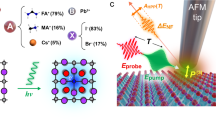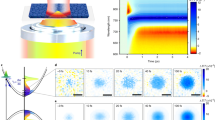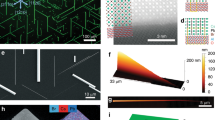Abstract
The nature of charge carriers in methylammonium lead iodide perovskites (MAPbI3) at room temperature is still a matter of considerable debate1,2,3. Here, we demonstrate that within single grains of MAPbI3, strong spatial heterogeneities on the nanometre length scale are present and associated with simultaneous free-carrier and exciton populations. These heterogeneous populations, hidden in ensemble measurements, have a signature of spatially resolved relaxation dynamics for above-bandgap photoexcitation. Using spectrally resolved transient absorption microscopy, we directly observe both red- and blueshifts of the band-edge absorption across individual grains due to a dynamic Stark shift and screening of excitonic transitions by hot carriers. These observations help address a long-standing debate on the identity of the charge carriers, showing that both excitons and free carriers coexist, but are spatially segregated on the length scale of hundreds of nanometres.
This is a preview of subscription content, access via your institution
Access options
Access Nature and 54 other Nature Portfolio journals
Get Nature+, our best-value online-access subscription
$29.99 / 30 days
cancel any time
Subscribe to this journal
Receive 12 print issues and online access
$209.00 per year
only $17.42 per issue
Buy this article
- Purchase on Springer Link
- Instant access to full article PDF
Prices may be subject to local taxes which are calculated during checkout




Similar content being viewed by others
References
Trinh, M. T., Wu, X. X., Niesner, D. & Zhu, X. Y. Many-body interactions in photo-excited lead iodide perovskite. J. Mater. Chem. A 3, 9285–9290 (2015).
Sheng, C. X. et al. Exciton versus free carrier photogeneration in organometal trihalide perovskites probed by broadband ultrafast polarization memory dynamics. Phys. Rev. Lett. 114, 116601 (2015).
Simpson, M. J., Doughty, B., Yang, B., Xiao, K. & Ma, Y.-Z. Spatial localization of excitons and charge carriers in hybrid perovskite thin films. J. Phys. Chem. Lett. 6, 3041–3047 (2015).
Gao, P., Gratzel, M. & Nazeeruddin, M. K. Organohalide lead perovskites for photovoltaic applications. Energy Environ. Sci. 7, 2448–2463 (2014).
Yang, B. et al. Perovskite solar cells with near 100% internal quantum efficiency based on large single crystalline grains and vertical bulk heterojunctions. J. Am. Chem. Soc. 137, 9210–9213 (2015).
Son, D.-Y. et al. Self-formed grain boundary healing layer for highly efficient CH3NH3PbI3 perovskite solar cells. Nat. Energy 1, 16081 (2016).
Park, N. G. Perovskite solar cells: an emerging photovoltaic technology. Mater. Today 18, 65–72 (2015).
Tan, Z. K. et al. Bright light-emitting diodes based on organometal halide perovskite. Nat. Nanotech. 9, 687–692 (2014).
D'Innocenzo, V. et al. Excitons versus free charges in organo-lead tri-halide perovskites. Nat. Commun. 5, 3586 (2014).
Miyata, A. et al. Direct measurement of the exciton binding energy and effective masses for charge carriers in organic–inorganic tri-halide perovskites. Nat. Phys. 11, 582–588 (2015).
Motta, C., El-Mellouhi, F. & Sanvito, S. Charge carrier mobility in hybrid halide perovskites. Sci. Rep. 5, 12746 (2015).
Johnston, M. B. & Herz, L. M. Hybrid perovskites for photovoltaics: charge-carrier recombination, diffusion, and radiative efficiencies. Acc. Chem. Res. 49, 146–154 (2016).
Guo, Z., Manser, J. S., Wan, Y., Kamat, P. V. & Huang, L. B. Spatial and temporal imaging of long-range charge transport in perovskite thin films by ultrafast microscopy. Nat. Commun. 6, 7471 (2015).
Sun, S. Y. et al. The origin of high efficiency in low-temperature solution-processable bilayer organometal halide hybrid solar cells. Energy Environ. Sci. 7, 399–407 (2014).
Even, J., Pedesseau, L. & Katan, C. Analysis of multivalley and multibandgap absorption and enhancement of free carriers related to exciton screening in hybrid perovskites. J. Phys. Chem. C 118, 11566–11572 (2014).
Yang, Y. et al. Large polarization-dependent exciton optical Stark effect in lead iodide perovskites. Nat. Commun. 7, 12613 (2016).
Price, M. B. et al. Hot-carrier cooling and photoinduced refractive index changes in organic–inorganic lead halide perovskites. Nat. Commun. 6, 8420 (2015).
Chen, K., Barker, A. J., Morgan, F. L. C., Halpert, J. E. & Hodgkiss, J. M. Effect of carrier thermalization dynamics on light emission and amplification in organometal halide perovskites. J. Phys. Chem. Lett. 6, 153–158 (2015).
Motta, C. et al. Revealing the role of organic cations in hybrid halide perovskite CH3NH3PbI3 . Nat. Commun. 6, 7026 (2015).
Yang, Y. et al. Observation of a hot-phonon bottleneck in lead-iodide perovskites. Nat. Photon. 10, 53–59 (2016).
Manser, J. S. & Kamat, P. V. Band filling with free charge carriers in organometal halide perovskites. Nat. Photon. 8, 737–743 (2014).
Kuokstis, E. et al. Two mechanisms of blueshift of edge emission in InGaN-based epilayers and multiple quantum wells. Appl. Phys. Lett. 80, 977–979 (2002).
Peyghambarian, N. et al. Blue shift of the exciton resonance due to exciton–exciton interactions in a multiple-quantum-well structure. Phys. Rev. Lett. 53, 2433–2436 (1984).
Wachter, S. et al. Excitation induced shift and broadening of the exciton resonance. Physica B 314, 309–313 (2002).
Bakulin, A. A. et al. Real-time observation of organic cation reorientation in methylammonium lead iodide perovskites. J. Phys. Chem. Lett. 6, 3663–3669 (2015).
Bublitz, G. U. & Boxer, S. G. Stark spectroscopy: applications in chemistry, biology, and materials science. Annu. Rev. Phys. Chem. 48, 213–242 (1997).
Grancini, G. et al. Role of microstructure in the electron–hole interaction of hybrid lead halide perovskites. Nat. Photon. 9, 695–701 (2015).
Valverde-Chavez, D. A. et al. Intrinsic femtosecond charge generation dynamics in single crystal CH3NH3PbI3 . Energy Environ. Sci. 8, 3700–3707 (2015).
Stoumpos, C. C., Malliakas, C. D. & Kanatzidis, M. G. Semiconducting tin and lead iodide perovskites with organic cations: phase transitions, high mobilities, and near-infrared photoluminescent properties. Inorg. Chem. 52, 9019–9038 (2013).
Soe, C. M. M. et al. Room temperature phase transition in methylammonium lead iodide perovskite thin films induced by hydrohalic acid additives. ChemSusChem 9, 2656–2665 (2016).
Acknowledgements
E.H. acknowledges support, in part, from the Air Force Office of Scientific Research (FA9550-14-1-0005) and the Packard Foundation (2013-39272). M.K. acknowledges support from the US Department of Energy, Office of Science, Basic Energy Sciences (DE-SC-0012541). The electron microscopy work made use of the EPIC facility of Northwestern University's NUANCE Center, which has received support from the Soft and Hybrid Nanotechnology Experimental (SHyNE) Resource (NSF ECCS-1542205); the MRSEC programme (NSF DMR-1121262) at the Materials Research Center; the International Institute for Nanotechnology (IIN); the Keck Foundation and the State of Illinois (through the IIN). S.N. acknowledges support from the Camille and Henry Dreyfus Postdoctoral Program in Environmental Chemistry.
Author information
Authors and Affiliations
Contributions
S.N., B.S. and E.H. conceived the ideas and designed the experiments. S.N. and B.S. carried out TAM experiments and S.N., B.S. and E.H. analysed the data. C.S. and C.M.M.S. synthesized the perovskite films and performed the XRD and diffuse reflectance measurements under the supervision of M.K. S.N., B.S. and E.H. contributed to writing the paper. All authors discussed the results in the paper.
Corresponding author
Ethics declarations
Competing interests
The authors declare no competing financial interests.
Supplementary information
Supplementary information
Supplementary information (PDF 709 kb)
Rights and permissions
About this article
Cite this article
Nah, S., Spokoyny, B., Stoumpos, C. et al. Spatially segregated free-carrier and exciton populations in individual lead halide perovskite grains. Nature Photon 11, 285–288 (2017). https://doi.org/10.1038/nphoton.2017.36
Received:
Accepted:
Published:
Issue Date:
DOI: https://doi.org/10.1038/nphoton.2017.36
This article is cited by
-
Nanoscale heterogeneity of ultrafast many-body carrier dynamics in triple cation perovskites
Nature Communications (2022)
-
Experimental characterization techniques for plasmon-assisted chemistry
Nature Reviews Chemistry (2022)
-
Coupled- and Independent-Trajectory Approaches Based on the Exact Factorization Using the PyUNIxMD Package
Topics in Current Chemistry (2022)
-
Strain engineering in perovskite solar cells and its impacts on carrier dynamics
Nature Communications (2019)
-
Metal halide perovskite nanostructures for optoelectronic applications and the study of physical properties
Nature Reviews Materials (2019)



